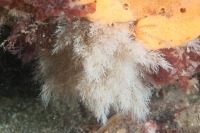
(Photo: Claire Goodwin)
Paired or Feathery Bryozoan
Eucratea loricata
These colonial animals form white, tree-like tufts. Usually around 10 centimetres in height but can be up to 25 centimetres. Colonies are formed of many small, box-like individuals called zooids. The zooids grow back-to-back in linear chains that look like branches.
Authority
Linnaeus, 1758
Classification Details
Phylum: Bryozoa (bryozoans); Cheilostomatida (calcified bryozoans).
Habitat
Found on a wide variety of substrates from low shore to around 80 to 100 metres deep. Particularly associated with strong current flow. Found from the Arctic to Cape Cod on eastern Canadian coasts. Also Europe, central Arctic, and western Canada.
Diet
Filter feeders that sieve small particles, mainly phytoplankton, out of the seawater. Each zooid in the colony has a feeding structure called a lophophore. This is a circle of tentacles with a mouth in the middle. Hairs on the tentacles beat to create a feeding current.
Reproduction
Most bryozoans are hermaphrodites (both male and female). Zooids in the colony release sperm into the water column. Sperm is then taken up by other zooids and fertilizes their eggs. Embryos (fertilized eggs) are brooded in special structures called ovisacs. Larvae are then released and settle and grow into another colony.
Fun Facts
This species provides a home for baby scallops. The scallop larvae settle onto the bryozoan colonies and live there until they are four to five millimetres long.
References
Bock P and Gordon D (2020). World List of Bryozoa. Eucratea loricata (Linnaeus, 1758). Accessed through: World Register of Marine Species at: http://www.marinespecies.org/aphia.php?p=taxdetails&id=111361 Accessed online 20 January 2020.
Dow RL and Baird FT (1960) Scallop resources of the United States Passamaquoddy area. U.S. Fisheries and Wildlife Service Special Scientific Reports on Fisheries No. 367. 9p.
Hayward PJ and Ryland JS (1998) Cheilostomatous Bryozoa. Part 1. Aeteoidea – Cribrilinoidea. Shrewsbury: Field Studies Council. [Synopses of the British Fauna, no. 10. (2nd edition)
Porter J (2012) Seasearch guide to the bryozoa and hydroids of Britain and Ireland. Marine Conservation Society. Ross-on-Wye.


